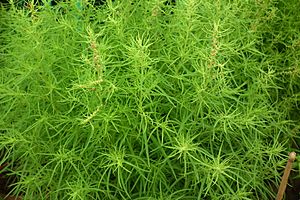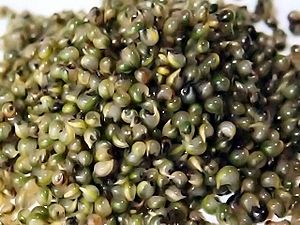Bassia scoparia facts for kids
Quick facts for kids Bassia scoparia |
|
|---|---|
 |
|
| Scientific classification | |
| Genus: |
Bassia
|
| Species: |
scoparia
|
| Synonyms | |
|
|
Bassia scoparia is a tall plant that grows for one year. It belongs to the Amaranthaceae family and originally comes from Europe and Asia. This plant has been brought to many parts of North America. There, you can find it growing in grasslands, prairies, and even desert areas.
People call it by many names, like summer cypress, kochia, burningbush, or Mexican firebrush. The last few names come from how its leaves turn a bright red color in the autumn.
Contents
About the Plant
The fruit of Bassia scoparia is a dull brown color. Inside, you'll find small, dull black seeds. In some places, like parts of Europe, the seeds can be dark or blackish-brown.
The seeds spread in two main ways: by wind and by water. Sometimes, the whole plant breaks off and rolls across the ground like a tumbleweed. This helps spread its seeds even further. The seeds don't last long in the soil; if they don't sprout within about a year, they usually die.
This plant is a special type called a C4 plant. This means it's very good at using sunlight to make its food, especially in warm, sunny places. Bassia scoparia can also become resistant to weed killers (herbicides) very quickly. In North America, some populations have even become resistant to four different kinds of weed killers!
Plant Names and History
The famous scientist Carl Linnaeus first described this plant in 1753. He named it Chenopodium scoparium. Later, in 1809, another botanist named Heinrich Schrader put it into a new group called Kochia.
Then, in 1978, Andrew J. Scott moved it again to the group Bassia. Scientists studied the plant's family tree (its phylogenetic relationships) and decided in 2011 that Kochia should be part of Bassia.
What It's Used For
People grow Bassia scoparia as an ornamental plant because its green leaves look nice in gardens. Its bright red color in the fall is also very popular. This plant is also helpful for stopping erosion, which is when soil gets washed away, especially on bare ground.
Scientists have also looked into using it for phytoremediation. This is a process where plants help clean up polluted soil. Bassia scoparia is a "hyperaccumulator," meaning it can soak up a lot of harmful metals like chromium, lead, mercury, selenium, silver, zinc, and even uranium from the soil.
Tonburi
In Japan, the dull black seeds of this plant are used as a food garnish called tonburi. Because its texture is similar to caviar, some people call it "land caviar" or "mountain caviar." It's considered a special food, or chinmi, in Akita prefecture. To prepare tonburi, the seeds are boiled for about 30 minutes. Then, they are soaked in running water and rubbed by hand to remove their outer shells.
Traditional Medicine
The seeds of Bassia scoparia are used in traditional Chinese medicine. People believe they can help with problems like high cholesterol, high blood pressure, and being overweight. One study on mice showed that an extract from the seeds helped limit weight gain in mice fed a high-fat diet. The seeds contain special natural compounds.
Animal Food
This plant can be used as forage (food) for livestock like cows and sheep, especially in dry areas. It has more protein and oxalate than most grasses. However, it can be harmful if animals eat too much of it. Large amounts can cause animals to lose weight and become sensitive to sunlight.
Brooms
In Japan, one of the plant's common names means 'broom-tree' or 'broom-weed'. This is because it has traditionally been used to make brooms.
In Serbia, people make simple brooms by tying several dried Bassia scoparia plants together. The branches form the broom head, and the stems act as the handle, making it very convenient.
Culture
An old Japanese legend says that this broom tree would disappear from sight whenever someone tried to get close to it. A famous poet named Sakanoue no Korenori even wrote a poem about this myth.
Gallery
See also
 In Spanish: Kochia scoparia para niños
In Spanish: Kochia scoparia para niños







